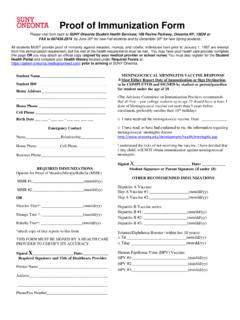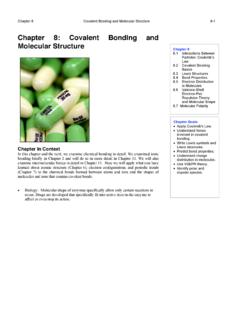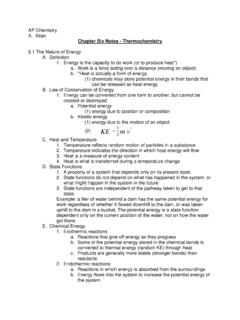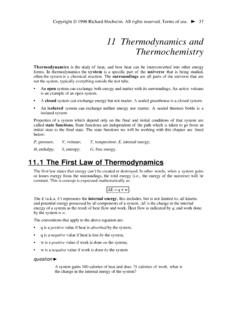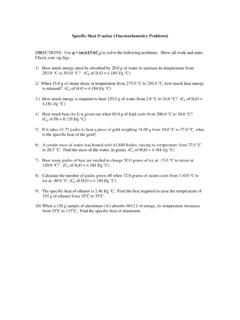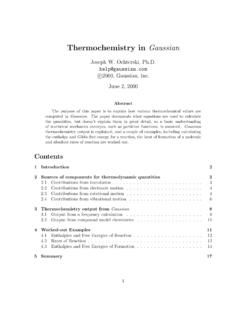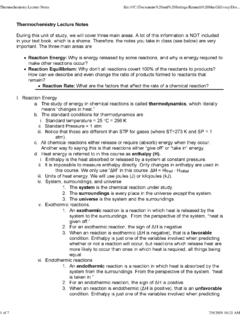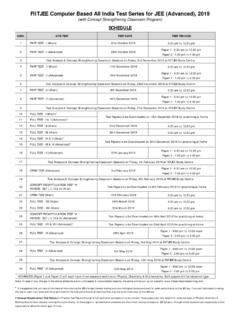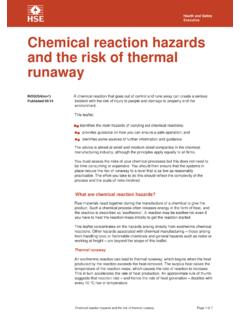Transcription of Chapter 5: Thermochemistry - SUNY Oneonta
1 Chapter 5 Thermochemistry 5-1 5-1 Chapter 5: Thermochemistry Chapter In Context In this Chapter we begin an exploration of Thermochemistry , the study of the role that energy in the form of heat plays in chemical processes. We will investigate the energy changes that take place during phase changes and the chemical reactions you have studied in previous chapters and learn why some chemical reactions occur while others do not.
2 In the Chapter that follows, we will study energy changes at the molecular level and the consequences those energy changes have on the properties of atoms and elements. Environmental Studies/Industry: A major portion of our economy is based on extracting potential energy from fossil fuels that have been built up over millions of years through photosynthesis, where plants chemically store energy obtained from sunlight. The energy is stored in the form of chemical compounds that are high in chemical potential energy.
3 Chemicals that are high in chemical potential energy can be made to react to give off heat, and that heat energy can in turn be used to run an engine or heat a home. During all these processes energy is transformed from one form to another, but is never really removed or added to. That is, energy is constant: our economy is based on finding sources of one type of energy (chemically stored potential energy) and turning it into another kind of energy (heat, thermal energy). Chapter 5 Energy Enthalpy Energy, Temperature Changes, and Changes of State Enthalpy Changes and Chemical Reactions Hess s Law Standard Heats of Reaction Chapter Goals Recognize different types of energy.
4 Understand the principles of thermodynamics including heat and work. Define enthalpy and understand its relationship to chemical systems. Relate energy to temperature change. Relate energy to physical change. Relate energy to chemical change. 5-2 Thermochemistry Chapter 5 Calculating Kinetic and Potential Energy Kinetic energy is calculated from the equation KE = mv2 m = mass v = velocity Potential energy calculations depend on the forces that exist between particles.
5 Because different types of particles experience different types of forces, it is not possible to use a single equation to calculate potential energy. Energy OWL Opening Exploration Types of Energy Chemical reactions involve reactants undergoing chemical change to form new substances, products. Reactants Products What is not apparent in the above equation is the role of energy in a reaction. For many reactions, energy, often in the form of heat, is absorbed that is, it acts somewhat like a reactant.
6 You might write an equation for those reactions that looks like this: Energy + Reactants Products In other reactions, energy is produced that is, it acts like a product: Reactants Products + Energy In many reactions, such as the combustion of gasoline in a car or natural gas on a stovetop burner, energy is the most important product. Energy is defined most simply as the ability to do work. Work is defined in many ways, the simplest definition being the force involved in moving an object some distance.
7 From a chemist s point of view, energy is best viewed as the ability to cause change, and Thermochemistry is the study of how energy in the form of heat is involved in chemical change. Kinetic and Potential Energy Energy takes many forms such as mechanical, electrical, or gravitational. These are categorized into two broad classes: kinetic energy, energy associated with motion, and potential energy, energy associated with position. Most of the events we see around us involve conversion of energy from one form to another.
8 Consider the use of a small photocell to run a fan (Figure ). Figure A photoelectric cell drives this small fan. In this example, light (radiant energy) is absorbed by the photocell, which converts it into an electric current. That electric current is then used to drive the fan. The energy conversions occurring are therefore: radiant (kinetic and potential) electrical (kinetic and potential) mechanical (kinetic) Measuring Energy: Energy Units Energy is measured in different units. For example, heating fuel is typically measured in British Thermal Units, BTUs, and food energy content is measured in Calories.
9 Energy Chapter Goals Revisited Recognize different types of energy. Use and interconvert energy units. Chapter 5 Thermochemistry 5-3 5-3 1 J = 1 kg m2/s2 associated with most chemical processes is reported in terms of joules (J) and kilojoules (kJ), or calories (cal) and kilocalories (kcal). The food energy unit, Calorie, is equal to 1 kcal.
10 One joule is equal to the energy needed to accelerate a 1 kg object by 1 m2/s2. One calorie is the energy needed to raise the temperature of one gram of pure water by one degree Celsius. Table shows conversion factors for joules, calories, BTU, and kilowatt-hours, the energy unit used in measuring electrical energy. Table Energy unit conversion factors J kJ cal kcal kWh BTU 1 J = 1 10 4 10 7 10 4 1 kJ = 1000 1 10 4 1 cal = 10 3 1 10 6 10 3 1 kcal = 4184 1000 1 10 3 1 kWH = 106 103 105 1 3143 1 BTU = 1055 252 10 4 1
